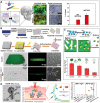Antibacterial micro/nanomotors: current research progress, challenges, and opportunities
- PMID: 38250044
- PMCID: PMC10797294
- DOI: 10.7150/thno.92449
Antibacterial micro/nanomotors: current research progress, challenges, and opportunities
Abstract
Bacterial infections remain a formidable threat to human health, a situation exacerbated by the escalating problem of antibiotic resistance. While alternative antibacterial strategies such as oxidants, heat treatments, and metal nanoparticles (NPs) have shown potential, they come with significant drawbacks, ranging from non-specificity to potential environmental concerns. In the face of these challenges, the rapid evolution of micro/nanomotors (MNMs) stands out as a revolutionary development in the antimicrobial arena. MNMs harness various forms of energy and convert it into a substantial driving force, offering bright prospects for combating microbial threats. MNMs' mobility allows for swift and targeted interaction with bacteria, which not only improves the carrying potential of therapeutic agents but also narrows the required activation range for non-drug antimicrobial interventions like photothermal and photodynamic therapies, substantially improving their bacterial clearance rates. In this review, we summarized the diverse propulsion mechanisms of MNMs employed in antimicrobial applications and articulated their multiple functions, which include direct bactericidal action, capture and removal of microorganisms, detoxification processes, and the innovative detection of bacteria and associated toxins. Despite MNMs' potential to revolutionize antibacterial research, the translation from laboratory to clinical use remains challenging. Based on the current research status, we summarized the potential challenges and possible solutions and also prospected several key directions for future studies of MNMs for antimicrobial purposes. Collectively, by highlighting the important knowns and unknowns of antimicrobial MNMs, our present review would help to light the way forward for the field of antimicrobial MNMs and prevent unnecessary blindness and detours.
Keywords: bacterial infections; challenges; micro/nanomotors; opportunities.
© The author(s).
Conflict of interest statement
Competing Interests: The authors have declared that no competing interest exists.
Figures







Similar articles
-
Micro/nanomotors in targeted drug delivery: Advances, challenges, and future directions.Int J Pharm. 2025 Apr 15;674:125471. doi: 10.1016/j.ijpharm.2025.125471. Epub 2025 Mar 14. Int J Pharm. 2025. PMID: 40090636 Review.
-
Antibacterial micro/nanomotors: advancing biofilm research to support medical applications.J Nanobiotechnology. 2023 Oct 24;21(1):388. doi: 10.1186/s12951-023-02162-0. J Nanobiotechnology. 2023. PMID: 37875896 Free PMC article. Review.
-
Antibacterial and Biofilm Removal Strategies Based on Micro/Nanomotors in the Biomedical Field.ChemMedChem. 2024 Nov 4;19(21):e202400349. doi: 10.1002/cmdc.202400349. Epub 2024 Aug 23. ChemMedChem. 2024. PMID: 38965060 Review.
-
Liquid Metal Amplified Charge Separation in Photocatalytic Micro/Nanomotors for Antibacterial Therapy.ACS Nano. 2025 Jun 3;19(21):20037-20050. doi: 10.1021/acsnano.5c03785. Epub 2025 May 19. ACS Nano. 2025. PMID: 40390337
-
[Application of self-propelled micro-/nanomotors in active targeted drug delivery].Nan Fang Yi Ke Da Xue Xue Bao. 2020 Mar 30;40(3):445-452. doi: 10.12122/j.issn.1673-4254.2020.03.25. Nan Fang Yi Ke Da Xue Xue Bao. 2020. PMID: 32376586 Free PMC article. Review. Chinese.
Cited by
-
Design and application of antimicrobial nanomaterials in the treatment of periodontitis.Nanomedicine (Lond). 2025 Apr;20(7):707-723. doi: 10.1080/17435889.2025.2469492. Epub 2025 Mar 5. Nanomedicine (Lond). 2025. PMID: 40042364 Review.
References
-
- Xie S, Huang K, Peng J, Liu Y, Cao W, Zhang D. et al. Self-Propelling Nanomotors Integrated with Biofilm Microenvironment-Activated NO Release to Accelerate Healing of Bacteria-Infected Diabetic Wounds. Adv Healthc Mater. 2022;11(19):e2201323. - PubMed
-
- Jiang Q, E F, Tian J, Yang J, Zhang J, Cheng Y. Light-Excited Antibiotics for Potentiating Bacterial Killing via Reactive Oxygen Species Generation. ACS Appl Mater Interfaces. 2020;12(14):16150–8. - PubMed
-
- Park SH, Ricke SC. Development of multiplex PCR assay for simultaneous detection of Salmonella genus, Salmonella subspecies I, Salm. Enteritidis, Salm. Heidelberg and Salm. Typhimurium. J Appl Microbiol. 2015;118(1):152–60. - PubMed
Publication types
MeSH terms
Substances
LinkOut - more resources
Full Text Sources

